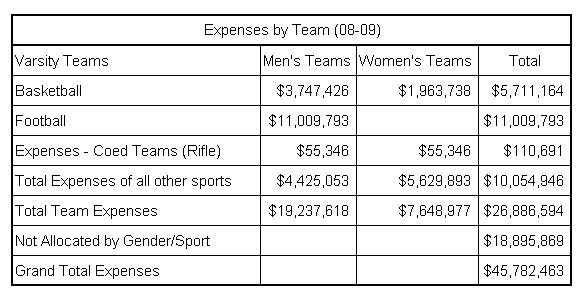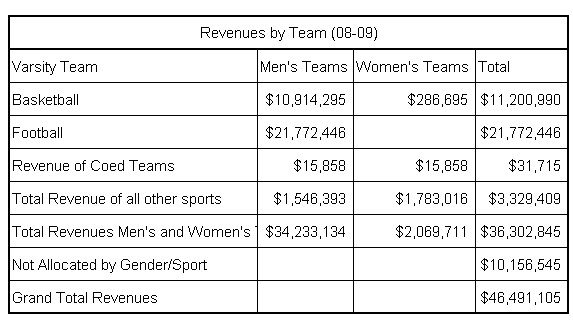Written by VAWolf, posted by SFN:
In the first installment of this series, we set the framework of how to look at financial reporting in college athletics with the following statement:
Information is only as accurate and complete as what the individual schools choose to report. There is NO consistent set of standards or normalizing process that is applied to the financial reports of different schools.
[snip]
Since this kind of financial reporting is not governed by “Generally Accepted Accounting Principles†a school can choose to take take two generally different approaches when reporting financial information: (1) attempt to report the most comprehensive and detailed view of the entire athletics endeavor of their university, or (2) share what could be a more narrow sliver of their entire athletics pie by focusing on just the ‘athletics department budget’.
You pretty much have to read the first installment before you can move ahead and take a closer look at some of the EIA reported numbers:
(1) SALARIES & COACHES’ COMPENSATIONS – If you drill down through NC State’s section of the EIA website, you will discover that the salaries paid to head coaches of ALL men’s sports totals $1,710,945.
If you’ve paid attention to news reports and various articles here at SFN, you would know that the total compensation packages of coaches can vary wildly from what is contractually owed/paid to them by the actual University. Jeff’s article on How Coaches Are Paid, is recommended so you can catch up on how compensation packages for head coaches are frequently structured (especially at large public institutions).
Obviously, only a small portion of Coach O’Brien and Coach Lowe’s total compensation are direct expenditures of the Athletics Department and are therefore being reported at EIA. (For those that need a refresher, here is a summary of their total compensation packages from 2006.) Thus it is reasonable to conclude that only the money paid directly from the athletic dept budget is being reported at EIA for NC State.
The key point in this discussion is the realization that what is being shown as “Total of Head Coaches’ Salaries†is in fact missing a lot of “stuffâ€. Which then poses the next question – what else is missing from other line items and entries at EIA?
(2) BUDGET PHILOSOPHY – Let’s look at quick summary of the expenses reported for NC State athletics recognizing that when 40% of your operating expenses are filed under “miscellaneousâ€, you aren’t going out of your way to provide detail and transparency on expenditures.
- Doesn’t $3M dollars in revenue from the ‘non-revenue’ sports sound high to you? If you download the .csv files from the EIA website, you will see that there is revenue reported for each and every sport. My conclusion is that this revenue from non-revenue sports is the scholarship money transferred from the Wolfpack Club to the athletic dept and then to the university. In a recent interview, Debbie Yow confirmed that the scholarship funding is paid to the athletic dept from the Wolfpack Club. Combining the two pieces of information justifies including the scholarship money into our FB revenue estimate
- ‘Unallocated revenue’ of $10M is in the same ball park as what the ACC distributes to each school. This ACC-distributed revenue comes from TV contracts, bowl game revenues, and NCAAT appearances. The ACC evenly distributes the revenue generated from these sources listed above among all 12 schools. After looking at these numbers for several years, I’m convinced that this is where State reports the money received from the ACC.
Take a quick look at some numbers reported by our conference and academic peers from Georgia Tech. For the 08/09 academic year, GT reported the following grand totals for expenses and revenues:
Grand Total Expenses – $48,061,053
Grand Total Revenue – $48,061,053
Amazing, huh?
Obviously money is being transferred INTO the GT athletic dept or OUT OF the athletic dept through those “miscellaneous†categories. Which raises the questions…where is the money going? Or where did the money come from?
For years, Maryland reported the exact same thing that GT reported this year – revenue & expenses magically balanced to the nearest dollar. Debbie Yow’s financial performance at Maryland can be summarized from recent articles by the following bullets:
- Balanced athletic dept budgets for 16 years
- $180MM worth of upgrades and renovations to facilities
- Cut athletic department debt from $51MM to less than $7MM
It seems reasonable to conclude that Yow took the surplus from each annual budget and combined that with some other form of revenue like donations to pay down the athletic department’s debt obligations while at the same time upgrading facilities. One could therefore conclude that the financial picture for Maryland athletics may have been much better than what you would conclude from just the numbers presented at EIA.
(3) SCHOLARSHIP COSTS – Since it looks like scholarships are being reported, we need to calculate what the Wolfpack Club pays for scholarships. Using the unduplicated number of athletes from EIA and the total academic expenses, we get:
Men – $3.1MM for 330 athletes = $9,495 each
Women – $2.0MM for 201 athletes = $9,827 each
Since the per athlete cost is skewed by walk-ons in the participation numbers, we can justify rounding off scholarship funding at $10,000 each.
(4) FOOTBALL REVENUE – Let’s look at the numbers we know, make some ball park estimates on those that we don’t, and see what what we think football revenue should be. Here are the sorts of things that could be attributed to revenue just from football: Game Day tickets – regular tickets; Club Seats; Luxury Suites; Profits from concessions; Parking passes; ACC TV Contract; Payments for Lifetime Seating Rights; Payments from Wolfpack Club for scholarships.
The NCAA reports that State ranked 36th in the country in 2008 attendance with a total attendance of 396,658 for a seven-game average of 56,665. So we’ll use this to break down revenue:
5000 students per game (SWAG) = $0 tickets
955 club seats at $1700/seat = $1.6M
50 suites (max 18/suite) at $50,000 average = $2.5M
50,000 tickets at $40 ea for 7 games = $14M
85 scholarships at $10,000 ea = $0.85M
10,000 parking passes (SWAG) at $100 ea = $1.0M
Concessions profit of $5 for each of 55,000 per game = $1.9M
Which gives us football revenue of $21.9M compared to the reported revenue of $21.7M. (Not bad if I do say so myself.)
But what about LifeTime Rights (“LTR”) for seats? I couldn’t find anything about how many LTRs have been sold, but let’s take another SWAG:
35,000 LTRs at average cost of $2000 (low) over 10 years = $7M per year.
I understand that the LTRs are essentially pass-through revenue to cover financing for expansions at Carter-Finley and the RBC Center, but that would not preclude it from being reported as revenue on the top line followed by interest expense in expenditures and principal paydown’s on the cashflow statement.
That looks like a lot of money that is simply not showing up in the EIA numbers. And if the LTR revenue is not showing up, then it’s a pretty good guess that the capital expenditure that LTR’s are funding doesn’t show up either.)
While I have been known to defend my conclusions to the death ;-), these numbers include quite a bit of speculation. If you have any data to show that any of these football numbers are far off, I would appreciate it if you would share the info in the comments or by e-mail if you wish to remain anonymous. (I’m sure that Derek will get any e-mail responses to me.)
CONCLUDING THOUGHTS
I think that it is pretty obvious that full-disclosure is not what you will find at Equity in Athletics. (But it’s almost the only information we have on athletic department budgets.) I am reminded of a quote from TOB that I will steal and reword:
The numbers found at EIA are a lot like a bikini. What they reveal is interesting, but what they conceal could be vital.
So when you want to tackle something like analyzing the finances of major college sports, you need to be really careful with the conclusions that you draw…especially when comparing one program to another. But even though we don’t have the complete picture, I think that there are still some things of interest to fans, alumni, boosters, and taxpayers that warrant further discussion. In Part 3, we’ll take a look at how the numbers from EIA look across the ACC.
I make no promises on when the remaining entries will appear, but my goal is to completely finish before Labor Day and hopefully by the end of the month.





You must be logged in to post a comment.